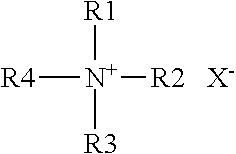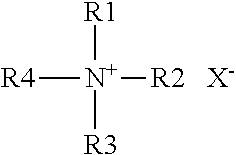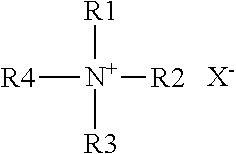Antimicrobial treatment of synthetic nonwoven textiles
a technology of synthetic nonwoven textiles and antimicrobial treatment, which is applied in the direction of biocide, disinfectants, dead animal preservation, etc., can solve the problems of difficult treatment, significant number of infections still occurring, and serious hospital acquired infections (hais) can be quite serious and dangerous, and achieves rapid wetting of the antimicrobial substrate, short contact time, and increase in bacteria count
- Summary
- Abstract
- Description
- Claims
- Application Information
AI Technical Summary
Benefits of technology
Problems solved by technology
Method used
Image
Examples
example 1
Preparation of Antimicrobial Polypropylene Nonwoven Fabric
[0096]A sheet of polypropylene nonwoven fabric (30 gsm) is soaked in a 1% aqueous solution of carboxymethyl cellulose, CMC (average M.W. 90000, degree of substitution 0.7) until completely wetted. The excess solution is then removed by padding and then the sheet is air dried followed by drying in an 80° C. oven for at least one hour. The resulting sheet contains 2.2 wt / wt % of carboxymethyl cellulose based on the total weight of the fabric. An aqueous solution of the cationic antimicrobial cetyltrimethylammonium chloride is sprayed onto the surface of the carboxymethyl cellulose treated textile and the resulting fabric is dried to provide a polypropylene nonwoven sheet containing 2.2 wt / wt % of carboxymethyl cellulose and 3.4 wt / wt % of cetyltrimethylammonium chloride based on the total weight of the fabric.
[0097]The durability is illustrated by soaking the sheet in water for one hour, removing the sheet from the water bath, ...
example 2
Antimicrobial Activity
[0098]A polypropylene nonwoven sheet prepared according to example 1 and containing 2.2 wt / wt % of carboxymethyl cellulose and 3.4 wt / wt % of cetyltrimethylammonium chloride is innoculated with Escherichia coli gram (−) and Staphylococcus aureus gram (+) bacteria as described above. The innoculated samples are incubated in a humid chamber at 37° C. for 5 minutes before transferring the samples into “Stomacher bags” as above. The sheet showed a greater than log 4.8 reduction against E. coli and a greater than log 4.2 reduction against S. aureus. Even after soaking treated textile samples in water for one hour before testing for antimicrobial action, the fabric still displayed a greater than log 4 reduction against both E. coli and S. aureus.
example 3
Demonstration of Leach Resistance of Antimicrobial Polypropylene Nonwoven Fabric
[0099]Two sheets of polypropylene nonwoven fabric (30 gsm) are soaked in a 0.5% aqueous solution of carboxymethyl cellulose (average M.W. 90000, degree of substitution 0.7) until completely wetted. The excess solution is then removed by padding and then the sheets are air dried followed by drying in an 80° C. oven for at least one hour. The resulting sheets contains 1.7 wt / wt % of carboxymethyl cellulose based on the total weight of the fabric. One sheet is sprayed with a 0.35% aqueous solution of the cationic antimicrobial cetyltrimethylammonium chloride and the other is sprayed with a 0.5% aqueous solution the cationic antimicrobial cetyltrimethylammonium chloride. The resulting fabrics are dried to provide a polypropylene nonwoven sheet containing 1.7 wt / wt % of carboxymethyl cellulose and 1.2 wt / wt % and 2.0% respectively of cetyltrimethylammonium chloride based on the total weight of the fabric.
The ...
PUM
| Property | Measurement | Unit |
|---|---|---|
| Fraction | aaaaa | aaaaa |
| Fraction | aaaaa | aaaaa |
| Fraction | aaaaa | aaaaa |
Abstract
Description
Claims
Application Information
 Login to View More
Login to View More - R&D
- Intellectual Property
- Life Sciences
- Materials
- Tech Scout
- Unparalleled Data Quality
- Higher Quality Content
- 60% Fewer Hallucinations
Browse by: Latest US Patents, China's latest patents, Technical Efficacy Thesaurus, Application Domain, Technology Topic, Popular Technical Reports.
© 2025 PatSnap. All rights reserved.Legal|Privacy policy|Modern Slavery Act Transparency Statement|Sitemap|About US| Contact US: help@patsnap.com



